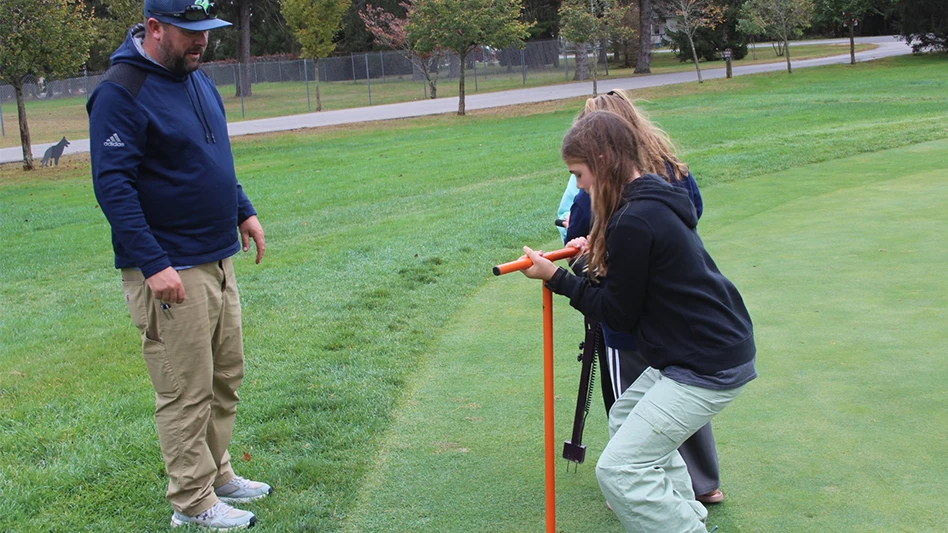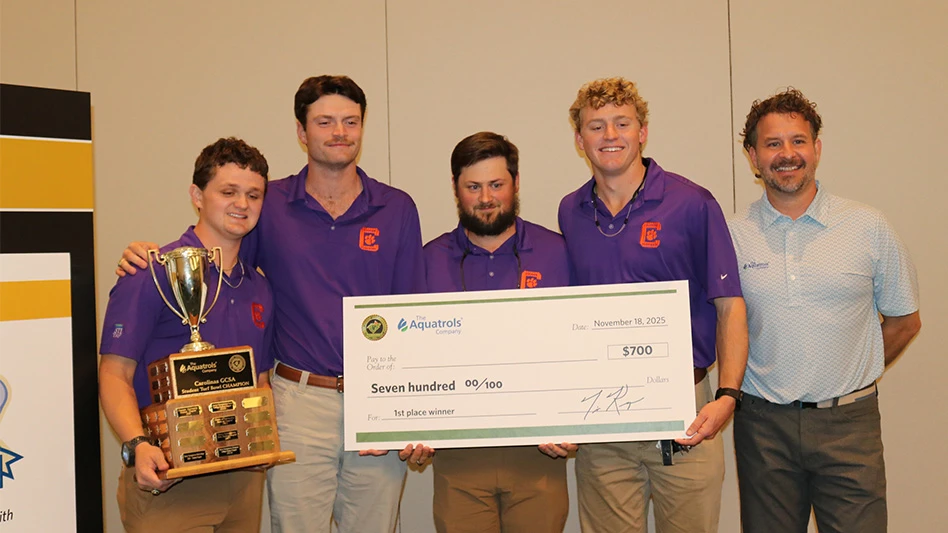
Richard Muniz Photography, courtesy of Tim Huber
Editor’s note: Golf Course Industry is working with SePRO to tell the story of Zio Fungicide’s implementation into disease control programs. The three-part series will explore the reasons superintendents are turning to Zio, how they are using it and what are the results during the most trying moments of the 2020 season.
Kevin Banks shattered an ankle earlier this year, an unusual but not unprecedented souvenir of a winter ski trip. A spring and summer filled with recovery and physical therapy prevented any efforts to crawl down close to the turf at Vineyard Golf Club — which is a shame, because the turf there turned in a sparkling season.
Banks is the superintendent at Vineyard Golf Club on Martha’s Vineyard. The course is required to use all organic products. With limited course maintenance options, Banks tested Zio Fungicide from SePRO this season, one of many superintendents across the country to include the product in their rotations.
Banks tank mixed it, spraying the course’s bentgrass/Poa annua greens every three to four days over a condensed peak stretch of 10 weeks, down from the normal 12 weeks in large thanks to near-constant winds blowing in off the Atlantic Ocean. He wanted to monitor how brown patch outbreaks reacted to a new chemistry — and wound up with results that will keep it Zio his program.
“This was the first summer I sprayed greens twice a week,” he says. “We had to turn back our five- or seven-days intervals and I sprayed at a two-and-a-half-ounce rate every three or four days. The turf reacted really well to that, and I found myself using Zio maybe a little more.”
Temperatures on the island were still mild when Banks ran out of his supply, hovering around 75 overnight. He had sprayed Zio a dozen times by then, a large enough sample size to recognize that brown patch outbreaks would vanish after three or four days rather than one or two weeks.
“Some greens, we have more thatch issue, some greens might have more rings, but in years past we would see it for up to seven to 13 days before it disappeared,” Banks says. “I think Zio contributed. Especially once we stopped using it, I saw more outbreaks on the golf course here and there. We have also been aggressive with our cultural practices. We DryJect our greens three times a year, and between April and September we only skipped one week of topdressing due to weather, so we were very active. I wouldn’t say Zio alone contributed to that, but it aided in the suppression of brown patch this year.”
Half a country away, Bill Irving turned to Zio to help control root Pythium on the 50-year-old bentgrass greens at Wolf Creek, a private club in Olathe, Kansas, on the west side of suburban Kansas City. The summers there are hot — “Cool for us would be highs in the upper 80s to low 90s,” Irving says — but the thermometer never cracked triple digits this season.
“The last three summers have been pretty pleasant,” says Irving the club’s director of agronomy. “We had a little spell this year in the middle of August when we showed up to work wearing sweatshirts, which is unheard of for us.”
The relief of rain lifted some of the burden on the greens, with a couple weeks of heat normally followed by a couple days of precipitation. The relief of a new product likely contributed, too.
“Our greens have many, many issues,” Irving says, “so it was nice that we were able to see them show some signs of stress, which is not unexpected in our neck of the woods, but then we would get on top of them and we would see that bounceback and that recovery. In the past, we hadn’t seen that. I don’t know that the Zio was solely responsible for the change, but I think it certainly helped us.”
Irving mixed Zio with a variety of other root Pythium products, applying “about an ounce per thousand” every other week, with a trio of other products on six-week rotations, over the course of the summer. A couple times, Irving says, weather pushed back applications a day or two, “and boy, the greens just had a funny look to them.” Within a day or two after the next application, “Boom, they looked normal again.”
“I’ve got some greens on my property right now that, every year, we’ve lost grass — I’m talking five or six plugs on a collar — and this year there was none,” he says. “There was no loss of turf on our eighth green at all. There were a handful of others where we still had to do some plugging but I think that was more wear and tear. I think the stresses we saw on those particular greens were more abiotic rather than a biotic stressor. It was water cooling or traffic stress rather than a Pythium or a root-born pathogen.”
By now, Irving considers Zio to be “another bullet in the chamber for protection on our greens,” and he considers it to be the kind of product that builds on itself, season after season. “I feel better putting it in the tank because now I have something else as I rotate my chemistries that helps us maintain that consistency that we need to have,” he says. “If we have that little weather hiccup and we’re late getting that application down, we know we have that Zio hanging around in the soil, lending us a hand in the fight.”
That fight is just starting at The Club at Carlton Woods, nestled in The Woodlands, about 30 miles north of Houston.
“Other than battling hot spots, the nice thing about the summer here is that we don’t see a lot of disease, we don’t see Pythium like they do in the north, especially the Northeast,” says Tim Huber, the director of agronomy for the club’s Nicklaus and Fazio courses. “Our season that we’re scared about is flip-flopped, so right now is when we’re starting to worry about leaf spot, dollar spot, Pythium, root disfunction, stuff like that, starting late September basically through February. Your Bermudagrass greens are just sitting dormant and they’re slowing down, you’re not growing new roots or producing new leaf tissue, so you get in this defensive mode.”
Huber has Zio on hand, and while he opted to not use it this summer because of hotter and drier conditions, he is prepared to include it in his fungicide rotation, most likely every 21 to 28 days, about five applications in all over the fall and winter.
“We rotate fungicides for Pythium root dysfunction and I think Zio is part of that because it adds a little biological control,” he says. “The pathogens see something different, the spectrum of protection, if that makes sense.
“We want to spray on a preventative basis. We want to make sure we’re not just spraying to spray.”
Latest from Golf Course Industry
- From the publisher’s pen: Conscientious of a bigger role
- Bernhard and Company partners with Laguna Golf Phuket
- Terre Blanche showcases environmental stewardship
- VIDEO: Introducing our December issue
- Bernhard and Company introduces Soil Scout
- Nu-Pipe donates to GCSAA Foundation’s Centennial Campaign
- GCSAA enhances golf course BMP tool
- Melrose leadership programs sending 18 to 2026 GCSAA Conference and Trade Show





